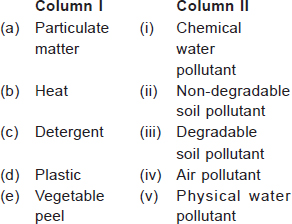Subject :NSO Class : Class 5
Subject :NSO Class : Class 5
Post Your Answer
Subject :NSO Class : Class 5
Ans 2:
Class : Class 5
BMarble is a metamorphic rock which is formed when limestone is exposed to high temperatures and pressures. It is not formed by cooling of lava.
Ans 3: (Master Answer)
Class : Class 1
B
Marble is a metamorphic rock which is formed when limestone is exposed to high temperatures and pressures. It is not formed by cooling of lava.
Post Your Answer
Subject :NSO Class : Class 4
Ans 1: (Master Answer)
Post Your Answer
Subject :NSO Class : Class 4
Post Your Answer
Subject :NSO Class : Class 4
Ans 2: (Master Answer)
Class : Class 1
D
Potted plant would be able to carry out the process of making food under the condition given in option D because it is getting sufficient sunlight, air and water from the soil. Under the condition given in option A it will not get proper light and the condition given in option B it will not get water, as soil is dry. In the condition given in option C it will not get air as vaseline blocks the stomata and prevents the entry of air into it.
Post Your Answer
Subject :NSO Class : Class 4
Post Your Answer
Subject :NSO Class : Class 4
Ans 1:
Class : Class 6
A is correct because leaves make the food for any plant (that's why it is called the kitchen of the plant) but unusual plants like insectivourous plants like pitcher plant as given in the options cannot make their own food thus they eat insects. That's why they are the odd one .
Ans 2:
Class : Class 4
Somesh ur right but not for the correct reason, insectivorus plants CAN do photosintesis but they eat insects to fulfill their nitrogen needs
Post Your Answer
Subject :NSO Class : Class 9
Post Your Answer
Subject :NSO Class : Class 6















